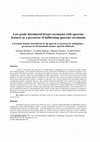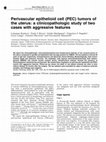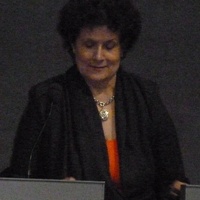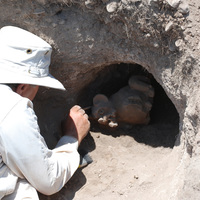Papers by Francisco Nogales
Journal of Clinical Pathology, Dec 1, 2005
The use of general descriptive names, registered names, trademarks, service marks, etc. in this p... more The use of general descriptive names, registered names, trademarks, service marks, etc. in this publication does not imply, even in the absence of a specific statement, that such names are exempt from the relevant protective laws and regulations and therefore free for general use.

Clinical Cancer Research, 2006
Purpose: To analyze immunohistochemically morules in endometrioid lesions to show that CD10 is a ... more Purpose: To analyze immunohistochemically morules in endometrioid lesions to show that CD10 is a sensitive marker for morular metaplasia. Experimental Design: Immunohistochemical analysis of 53 instances of morular metaplasia comprising 1 cyclic endometrium and 52 endometrioid lesions associated with focal glandular complexity corresponding to 9 polyps, 4 atypical polypoid adenomyomas, 24 complex endometrial hyperplasias (18 with and 6 without atypia), 12 grade 1 endometrioid adenocarcinomas in early clinical stages of both uterus and ovary, and three ovarian adenofibromas. Immunohistochemistry in paraffin sections was done for CD10, β-catenin, estrogen and progesterone receptors, and cytokeratins 5-6, 7, 8, 13, 18, 19, 20, and 34β-E12. Results: Morules were negative for estrogen and progesterone receptors and had β-catenin–positive nuclei. Cytokeratins 8, 18, 19 were positive; cytokeratins 7 and 20 were negative; and cytokeratins 5-6, 13, and 34β-E12 were weakly positive. All cases...

Pathology of the endometrium very small vessels resulting from neovascularization explain why the... more Pathology of the endometrium very small vessels resulting from neovascularization explain why the patient experiences hemorrhaging. Neovascularization is an essential part of the definition of a poiyp. Polyps in themselves do not present a risk for the patient but they result in a decrease in compliance to treatment as a result of the hemorrhaging. Hyperplasia without atypia generally occurs in patients who do not comply with treatment or in patients who have not taken the treatment for a sufficient number of days. Hyperplasia without atypia is associated with vascular thrombosis and explains why the patient is hemorrhaging. Endometrial carcinoma is sometimes diagnosed at biopsy as an incident case but in most cases the carcinoma is probably present prior to treatment and has not been discovered before because the patient was asymptomatic and no baseline was performed. Alternatively, the biopsy may have been done blindly and it could therefore have missed a small carcinoma. In the case of carcinoma, it is usually the invasion of the stroma that causes the bleeding.

A 50-year old patient was referred to the Department of Radiology for an annual screening mammogr... more A 50-year old patient was referred to the Department of Radiology for an annual screening mammogram. Radiologically, a non-palpable right breast lesion with microcalcifications was located in the upper external quadrant. On light microscopy, two adjacent but different lesions were identified that were both associated with apocrine adenosis, radial scar and proliferative fibro-cystic disease. The two areas of 8 respectively 10 mm diameter consisted of apocrine ductal carcinoma in situ (ADCIS) of low grade that intimately merged with distorted and compressed small clusters or tubules of apocrine cells with low grade nuclei and large amount of eosinophilic granular cytoplasm. However, these clusters lacked myoepithelial cells on both microscopic and immunohistochemical examinations and consecutively were interpreted as infiltrating areas of well differentiated apocrine carcinoma (AC). In this case, where small sized multifocal low grade infiltrating AC developed on a complex background...

Background: Perivascular epithelioid cells tumors (PEComas) conform a rare group of tumors that h... more Background: Perivascular epithelioid cells tumors (PEComas) conform a rare group of tumors that have been described preferently in the uterus. Objective: To report a case of malignant uterine perivascular epithelioid cell tumor in a 40-years-old woman. Material and methods: Pelvic ultrasonography revealed a polypoid mass in uterus. Pipelle biopsy showed a secretory endometrium with decidual change containing tumor with atypical epithelioid cells and abundant extracellular hyaline material. Results: The differential diagnoses considered according with the age of the patient and histologic findings were lesions of the intermediate trophoblast (epithelioid trophoblastic tumor, placental site trophoblastic tumor and exaggerated placental site), choriocarcinoma and leiomiosarcoma. The immunohistochemical study showed positivity for smooth muscle and HMB45, melan-A and smooth muscle actin with a proliferative index Ki67 of 50%. Discussion: Biopsy results were determinant of further clinic...
Gynecol Obstet Invest, 1950
Arch Gynecol Obstet, 1953

Human Pathology, 1999
Sertoli-Leydig cell tumors (SLCT) of the ovary are rare sex cord-stromal neoplasms. A minority of... more Sertoli-Leydig cell tumors (SLCT) of the ovary are rare sex cord-stromal neoplasms. A minority of SLCT are characterized by a pattern resembling that of the rete ovarii and frequently have a range of homologous and heterologous tissues. Approximately 20 cases of SLCT have been reported to have elevation of serum alpha-fetoprotein (AFP) levels, or tissue immunoreactivity for AFP, a protein usually associated with germ cell neoplasms, especially yolk sac tumor. We identified hepatocytic differentiation in five cases of retiform SLCT (RSLCT), and confirmed immunohistochemically that these cells are hepatocytes rather than Leydig cells. Hepatocytes are positive for keratins (AE1/3 and Cam 5.2), AFP, and ferritin, negative for vimentin, and show weak to moderate staining for inhibin. Leydig cells are negative for keratins, positive for vimentin, and intensely positive for inhibin. Immunohistochemistry is needed to distinguish hepatocytic differentiation from Leydig cells with certainty. Including the cases in this report, hepatocytic differentiation has been associated with a retiform pattern in SLCT in 14 of 25 cases (56%). The association of these two patterns appears to be characteristic of a relatively primitive sex cord-stromal neoplasm.
Current Diagnostic Pathology, 1995
*(US Slang) n. chaos.-adj. chaotic. [situation normal-all fouled (or fucked) up.
Archiv f�r Gyn�kologie, 1953

Human Pathology, 1996
The coexistence of mucinous ovarian and appendiceal tumors in association with pseudomyxoma perit... more The coexistence of mucinous ovarian and appendiceal tumors in association with pseudomyxoma peritonei (PP) is well established. However, it has not been determined whether they represent independent or metastatic neoplasms. The authors analyzed microsatellites on chromosome 17q 21.3-22 (nm23), 3p 25-26 (von Hippel Lindau disease [VHL] gene), and 5q 21-22 (D5S346 locus) in 12 synchronous ovarian and appendiceal mucinous lesions. Loss of heterozygosity (LOH) at the nm23 locus has been shown previously in ovarian carcinomas, and genetic alterations at both the 3p and 5q loci have been reported in colorectal carcinomas. The ovarian lesions consisted of nine mucinous tumors of low malignant potential and three invasive adenocarcinomas, and the appendiceal lesions consisted of eight carcinomas without invasion, two invasive carcinomas, and two mucosal hyperplasias. DNA was extracted from microdissected cells obtained from formalin-fixed, paraffin-embedded tissue sections and amplified by polymerase chain reaction. In three specimens, genetic alterations occurred at 17q 21.3-22 in only the ovarian tumors. One of these cases showed LOH on chromosome 5q 21-22 in only the appendiceal tumor. In three other specimens, LOH at the same locus was found in both tumors. Six specimens did not show LOH at any locus. These results suggest that a subset of synchronous mucinos ovarian and appendiceal lesions showing different LOH patterns in both sites most likely represent patients with two separate primary lesions. Another group of specimens with the same allelic loss in both tumors most likely represent patients with a single primary and metastatic spread. Thus, genetic analysis of these lesions may be useful in investigating the origin of histologically similar synchronous tumors.
Archiv f�r Gyn�kologie, 1966

Human Pathology, 1978
Four cases of polyvesicular vitelline tumor are presented; two were of a previously unreported pu... more Four cases of polyvesicular vitelline tumor are presented; two were of a previously unreported pure type, and the other two were mixed with endodermal sinus tumor. The morphologic features of the vesicles favor an endodermal origin, as originally proposed by Teilum. Marked specialization of the vesicular lining cells, seen ultrastructurally, suggests a differentiation toward gut structures and mature yolk sac. One case of pure polyvesicular vitelline tumor showed massive erythropoiesis. We propose that the pure tumor reflects an intermediate degree of differentiation within the selectively endodermal yolk sac tumor group, that is, a further stage of organization than the endodermal sinus tumor. In our cases of pure polyvesicular vitelline tumor, the marked degree of differentiation was correlated with an improved prognosis, as in the case of the possible homologue of this tumor, the yolk sac tumor of the infant testis. In contrast, the two cases of the tumor admixed with endodermal sinus tumor illustrated the low survival rate expected in the pure endodermal sinus tumor; in these cases the metastases had no polyvesicular component. Because of the significance of such a difference in prognosis we emphasize the importance of an accurate diagnosis, suggesting that a large number of sections be taken in order to demonstrate any endodermal sinus tumor component that may be present, and that the possibility of pure polyvesicular vitelline tumor always be considered in the differential diagnosis of multicystic ovarian tumors.

Modern Pathology, 2005
We report the clinicopathologic, immunohistochemical and ultrastructural features of two unusual ... more We report the clinicopathologic, immunohistochemical and ultrastructural features of two unusual tumors of the uterus composed of spindle and epithelioid cells strongly positive for HMB45. The two patients of 56 and 48 years of age had, respectively, hemoperitoneum and abnormal uterine bleeding. Morphologically, both tumors showed atypia and extensive necrosis. The neoplastic cells express immunohistochemically both melanogenesis (HMB45) and smooth muscle markers (actin). Ultrastructural analysis showed the presence of intracytoplasmic membrane-bound granules. We viewed these neoplasms as perivascular epithelioid cell (PEC) tumors with aggressive features. Follow-up has shown the death of one patient whereas the other is alive without disease 36 months after the surgery. The two patients were evaluated for signs of tuberous sclerosis complex, and findings were negative.
The Journal of Urology, 1995
An otherwise normal 48-year-old man had malignant large cell calcifying Sertoli cell tumor of the... more An otherwise normal 48-year-old man had malignant large cell calcifying Sertoli cell tumor of the testis. There were lymph node involvement and albugineal invasion at orchiectomy, and pulmonary metastases developed despite radiotherapy and chemotherapy. Our case and, to our knowledge, the only other reported case of malignant large cell calcifying Sertoli cell tumor had clinical and histopathological features related to

Journal of Cutaneous Pathology, 1993
A case of cesarean scar endometriosis with massive decidualization is presented. The 25-year-old ... more A case of cesarean scar endometriosis with massive decidualization is presented. The 25-year-old patient had an extensive, ulcerated lesion that mimicked malignancy microscopically due to myxoid change with alveolar patterns reminiscent of some soft tissue sarcomas, signet ring-like cells similar to mucin-producing carcinoma, and pseudoinfiltration of the fascia. The myxoid tissue was positive for acid mucopolysaccharides but negative with PAS. Decidual cells were vimentin positive and keratin negative. No atypia or mitoses were seen. The pseudoinfiltrative aspect was due to abundant extracellular matrix that separated the fascicles of the fascial tissue. There was a metaplastic decidual "proximity effect" in the surrounding, unaffected dermis, which may be responsible for the expansile features of the lesion. This case exemplifies the differential diagnosis of myxoid endometriosis with malignant conditions of the skin.
International Journal of Surgical Pathology, 2005
Testicular juvenile granulosa cell tumor (TJGCT) occurs predominantly in infancy and may be assoc... more Testicular juvenile granulosa cell tumor (TJGCT) occurs predominantly in infancy and may be associated with sex chromosomal abnormalities. We report a fetus aborted because of cytogenetically confirmed complete XXY triploidy. External genitalia of the fetus were female, with a short and patent vagina. The tumor presented as an abdominal multicystic mass with typical histologic and immunohistological features of JGCT. It was connected with a tubular uterus-like structure. The other gonad was an inguinally localized testis that showed histologically a Sertoli cell adenoma. Malformations typical for triploidy were also present: agenesis of the corpus callosum, stenosis of the pulmonary ostium, and hypoplasia of the lungs and adrenals. To our knowledge this is the first case of TJGCT in a triploid fetus.











Uploads
Papers by Francisco Nogales